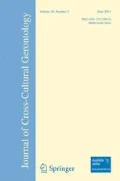Abstract
This qualitative study aimed to understand the meaning of quality of life to older persons with chronic illness in China, and to compare the perceptions of those living in rural and urban areas. Semi-structured interviews were conducted with 24 older Chinese, half residing in urban and half in rural areas in Shandong province. Through an inductive coding and categorization process, the study identified two shared domains of quality of life: basic necessities and family wellness. Two additional domains, physical health and mood and spirit, were endorsed predominantly by urban residents. Entertainment and leisure comprised a quality of life domain for urban residents only. Cohort experience and cultural values likely played a role in shared beliefs about quality of life, whereas socioeconomic context may account for differences in rural and urban conceptions. An implication of the findings is that for older Chinese with chronic illness, developing and sustaining programs to meet basic needs is critical to quality of life.
Similar content being viewed by others
References
Baker, H. (1979). Chinese family and kinship. NY: Columbia University Press.
Barcaccia, B., Esposito, G., Matarese, M., Bertolaso, M., Elvira, M., & De Marinis, M. G. (2013). Defining quality of life: a wild-goose chase? European Journal of Psychiatry, 9, 185–203. doi:10.5964/ejop.v9i1.484.
Burckhardt, C., Woogs, S., Schultz, A., & Ziebarth, D. (1989). Quality of life of adults with chronic illness: a psychometric study. Research in Nursing and Health, 12, 347–354.
Depp, C. A., & Jeste, D. V. (2006). Definitions and predictors of successful aging: A comprehensive review of larger quantitative studies. The American Journal of Geriatric Psychiatry, 14, 6–20. doi:10.1097/01.JGP.0000192501.03069.bc.
Dijkers, M. (2007). ‘What’s in a name?’ The indiscriminate use of the “Quality of Life” label, and the need to bring about clarity in conceptualizations. International Journal of Nursing Studies, 44, 153–155.
Gabriel, Z., & Bowling, A. (2004). Quality of life from the perspectives of older people. Ageing and Society, 24, 675–691. doi:10.1017/S0144686X03001582.
Grant, R. & Bowling, A. (2011). Challenges in comparing the quality of life of older people between ethnic groups, and the implications for national well-being indicators: a secondary analysis of two cross-sectional surveys. Health and Quality of Life Outcomes, 9(109). doi: 10.1186/1477-7525-9-109.
He, J., Gu, D., Chen, J., Hui, R., Klag, M. J., Kong, I., Tao, S., Wang, J., Whelton, P. K., Wu, X., & Yao, C. (2005). Major causes of death among men and women in China. New England Journal of Medicine, 353, 1124–1134. doi:10.1056/NEJMsa050467.
Holmes, S. (2005). Assessing the quality of life—reality or impossible dream? A discussion paper. International Journal of Nursing Studies, 42, 493–501.
Huang, Y. (2012). Family relations and life satisfaction of older people: a comparative study between two different hukous in China. Ageing and Society, 32, 19–40. doi:10.1017/S0144686X11000067.
Jian, W., Chan, K. Y., Reidpath, D. D., & Xu, L. (2010). China’s rural–urban gap shrank for chronic disease patients, but inequities persist. Health Affairs, 29, 2186–2196.
Kelley-Gillespie, N. (2009). An integrated conceptual model of quality of life for older adults based on a synthesis of the literature. Applied Research in Quality of Life, 4, 259–282. doi:10.1007/s11482-009-9075-9.
Ku, P.-W., Fox, K. R., & McKenna, J. (2008). Assessing subjective well-being in Chinese older adults: the Chinese aging well profile. Social Indicators Research, 87, 445–460. doi:10.1007/s11205-007-9150-2.
Lau, A., Chi, I., & McKenna, K. (1998). Self-perceived quality of life of Chinese elderly people in Hong Kong. Occupational Therapy International, 5, 118–139.
Leung, K.-K., Wu, E.-C., Lue, B.-H., & Tang, L.-T. (2004). The use of focus groups in evaluating quality of life components among elderly Chinese people. Quality of Life Research, 13, 179–190.
Levasseur, M., Tribble, D., & Desrosiers, J. (2009). Meaning of quality of life for older adults: importance of human functioning components. Archives of Gerontology and Geriatrics, 49, e91–e100. doi:10.1016/j.archger.2008.08.013.
Li, C., Yu, X., Butler, R. J., Yiengprugsawan, V., & Yu, M. (2011). Moving towards universal health insurance in China: performance, issues, and lessons from Thailand. Social Science and Medicine, 73, 359–366. doi:10.1016/j.socscimed.2011.06.002.
Lou, W. Q. V., Chi, I., & Mjelde-Mossey, L. (2008). Development and validation of a life satisfaction scale for Chinese elders. International Journal of Aging and Human Development, 67, 149–170. doi:10.2190/AG.67.2.c.
Molzahn, A. E., Kalfoss, M., Makaroff, K. S., & Skevington, S. M. (2011). Comparing the importance of different aspects of quality of life to older adults across diverse cultures. Age and Ageing, 40, 192–199. doi:10.1093/ageing/afq156.
Moons, P., Budts, W., & De Geest, S. (2006). Critique on the conceptualization of quality of life: a review and evaluation of different conceptual approaches. International Journal of Nursing Studies, 43, 891–901. doi:10.1016/j.ijnurstu.2006.03.015.
Rowe, J. W., & Kahn, R. L. (1997). Successful aging. The Gerontologist, 37, 433–440. doi:10.1093/geront/37.4.433.
Shandong, China (n.d.). Retrieved February 21, 2014, from http://www.shandong.gov.cn/col/col4707/index.html.
Treiman, D. (2012). The “difference between heaven and earth”: urban–rural disparities in well-being in China. Research in Social Stratification and Mobility, 30, 33–47. doi:10.1016/j.rssm.2011.10.001.
World Health Organization Quality of Life Group. (1995). The World Health Organization Quality Of Life (WHOQOL) assessment: position paper from the World Health Organization. Social Science & Medicine, 41, 1403–1409.
Zimmer, Z., Wen, M., & Kaneda, T. (2010). A multi-level analysis of urban/rural and socioeconomic differences in functional health status transition among older Chinese. Social Science & Medicine, 71, 559–567. doi:10.1016/j.soscimed.2010.03.048.
Acknowledgments
This study was supported by the Office of Vice President for Research, Institute for Research on Women and Gender, and Center for Chinese Studies at the University of Michigan. The authors thank the assistance provided by many individuals, including Yujie Sui, Lingzui Gao, Jiaan Zhang, Jin Li, Jin Bei, Min-Min Yeung, Siu-Ha Ho, and Karen Staller.
Author information
Authors and Affiliations
Corresponding author
Rights and permissions
About this article
Cite this article
Li, L.W., Essex, E.L. & Long, Y. Quality of Life as Perceived by Older Persons with Chronic Illness in Rural and Urban Shandong, China. J Cross Cult Gerontol 29, 417–428 (2014). https://doi.org/10.1007/s10823-014-9246-5
Published:
Issue Date:
DOI: https://doi.org/10.1007/s10823-014-9246-5




